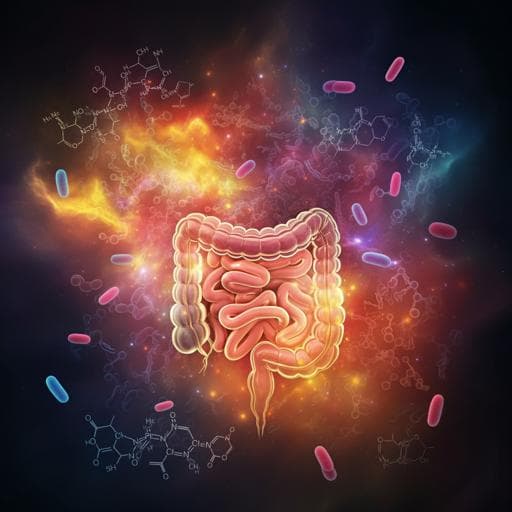
Biology
Xylan utilisation promotes adaptation of Bifidobacterium pseudocatenulatum to the human gastrointestinal tract
Y. Watanabe, Y. Saito, et al.
Discover how long-chain xylan (LCX) boosts the growth of Bifidobacterium pseudocatenulatum in the human gut! This groundbreaking research by authors Yohei Watanabe, Yuki Saito, Taeko Hara, and others highlights the potential for dietary strategies to enhance gut microbiota health through LCX utilization.
~3 min • Beginner • English
Introduction
The study investigates how specific carbohydrate availability shapes the adaptation and growth of human gut microbiota members, focusing on Bifidobacterium pseudocatenulatum in adult guts. While dietary glycans strongly influence the microbiota, the link between availability of particular carbohydrates for specific bacteria and their in situ growth in adults remains unclear. Bifidobacteria are core gut microbes rich in genes for carbohydrate metabolism, suggesting glycan use is central to their colonization and fitness. Infant-dominant bifidobacteria utilize human milk oligosaccharides, whereas adult-dominant taxa use plant-derived polysaccharides, including long-chain xylans (LCX) and their degradation products. LCX, a prevalent dietary fiber with a β-1,4-linked xylose backbone and decorations (e.g., arabinose), is typically degraded by a limited set of Bacteroidetes and Firmicutes via extracellular endo-1,4-β-xylanases (GH10). Bifidobacteria have been viewed as secondary consumers of LCX-derived oligosaccharides. The authors hypothesize that some B. pseudocatenulatum strains possess an endo-xylanase enabling primary LCX degradation, conferring an ecological advantage in LCX-rich environments, and that LCX availability in the human diet increases B. pseudocatenulatum abundance in individuals harboring such strains.
Literature Review
Prior work shows diet-derived glycans are key nutrients shaping gut microbiota composition, with HGM encoding diverse carbohydrate-active enzymes (CAZymes). In animal models and infants, specific carbohydrate niches drive colonization and adaptation. Xylan degradation in the gut has been characterized mainly in Bacteroidetes and Firmicutes, where GH10 endo-1,4-β-xylanases cleave LCX to release oligosaccharides, some of which become public goods for other microbes. Bifidobacteria generally utilize HMOs (infant taxa) or plant-derived oligosaccharides like XOS (adult taxa), and have been considered secondary consumers of LCX-derived oligosaccharides. However, the carbohydrate utilization of B. pseudocatenulatum, an adult-dominant species, has been less well characterized. This study builds on CAZyme profiling and established xylan degradation pathways to test for primary LCX degradation capacity in bifidobacteria.
Methodology
- Genome sequencing and analysis: 35 B. pseudocatenulatum strains (Yakult Central Institute collection) were isolated and identified by 16S rRNA gene analysis. Cultured in modified Gifu anaerobic medium with lactose and oligosaccharides at 37 °C anaerobically. Genomic DNA was sequenced using Illumina MiSeq, Oxford Nanopore MinION, and PacBio RS2 platforms (details in Supplementary Methods). Assemblies were performed with Unicycler; genome annotation with Prokka; CAZymes identified using dbCAN (HMMER, DIAMOND, Hotpep). A presence–absence matrix of putative CAZymes and pan-genome analysis were generated using Roary. 486 genomes across major bifidobacterial species were compared for CAZyme copy numbers.
- Carbohydrate utilization assays: 36 B. pseudocatenulatum strains (35 isolates plus type strain) were grown to exponential phase, washed, and inoculated into modified protein yeast (PY) medium supplemented with 1% (w/v) XOS or LCX substrates (arabinoxylan, xylan). Growth monitored by OD600 every 20 minutes for 48 h anaerobically at 37 °C. Organic acids in supernatants were quantified by HPLC.
- Cloning and protein production: The GH10 domain of BpXyn10A from strain YIT 11027 was PCR-amplified and cloned into pColdII (E. coli BL21 host). Recombinant protein was expressed, purified via Ni-NTA, and analyzed by SDS-PAGE.
- Endo-xylanase activity assays: Culture supernatants and cell fractions from LCX-utilizing (e.g., YIT 11027, YIT 11952) and non-utilizing (YIT 4027*) strains grown on LCX-associated media were tested with a specific Xylanase Assay Kit to detect endo-1,4-β-xylanase (not xylosidase/exo-xylanase). Thin-layer chromatography of reaction products assessed cleavage patterns of xylo-oligosaccharides.
- Enzyme supplementation growth tests: Non-LCX-utilizing strains (e.g., YIT 4027*, YIT 6161*) were grown in arabinoxylan medium supplemented with purified recombinant BpXyn10A (0–1000 μg/mL); growth was monitored by OD600.
- RNA-seq: LCX-utilizing strain YIT 11952 was cultured with lactose (control), xylose, XOS, arabinoxylan, and related carbohydrates. Total RNA was extracted, rRNA-depleted (RiboZero), libraries prepared, reads filtered (Cutadapt), mapped to the YIT 11952 genome (BWA/aligner as noted), and gene expression quantified (TPM). Differential expression was assessed to evaluate induction of BpXyn10A and adjacent gene clusters by LCX-associated substrates.
- Co-culture assays: Batch co-cultures of 36 B. pseudocatenulatum strains with Bacteroides ovatus YIT 6161* in PY medium with arabinoxylan as sole carbon source. Initial inocula were normalized (~1×10^6 cells/mL each). After 48 h anaerobic culture, DNA was extracted and species-specific qPCR quantified B. pseudocatenulatum and B. ovatus cell numbers. Time-series co-cultures with B. longum subsp. longum H1-1 assessed cross-feeding; species were quantified by qPCR over time.
- Human cereal intervention: Single-arm dietary intervention in Japanese adults (UMIN000043680), approved by Yakult Central Institute ethics committee. 30 enrolled; 27 completed (19 males, 8 females; 28–65 years). Participants consumed 60 g/day wheat bran-rich cereal (approx. 6.6 g/day wheat bran arabinoxylan) for 7 days (days 8–14), with pre- (days 1–7) and post- (days 15–21) periods. To minimize lactose effects, 80% lactose-depleted milk was used. Participants avoided other prebiotic products and LCX-rich foods. Fecal samples were collected on days 0, 7, 14, and 21; stored at −80 °C. DNA was extracted by bead-beating.
- qPCR quantification: B. pseudocatenulatum and B. adolescentis quantified by 16S rRNA gene-targeted qPCR. Absolute quantification used standard curves from known cell number DNA. Detection limit: 5.0×10^5 cells/g feces. BpXyn10A-positive cells were quantified using newly designed specific primers targeting BpXyn10A; primer specificity validated by Primer-BLAST and experimental testing against strain panel.
- 16S rRNA gene amplicon sequencing: V1–V2 regions were amplified and sequenced on MiSeq (v2, 500 cycles). DADA2 denoising, SILVA138 taxonomy assignment, alpha diversity (observed features, Faith’s PD, Shannon) and beta diversity (unweighted UniFrac) analyzed in QIIME2. ASVs with >97% identity to reference sequences were grouped to species-level bins.
- Statistics: Mann–Whitney U tests compared CAZyme copy numbers, organic acid production, and co-culture cell counts. Wilcoxon signed-rank tests evaluated within-group changes (e.g., cereal intervention effects). PERMANOVA tested beta-diversity differences; Kruskal–Wallis compared Shannon indices.
Key Findings
- CAZyme profiling across 486 genomes showed B. pseudocatenulatum is enriched for xylan degradation-related CAZymes, notably GH10, compared with other bifidobacterial species. HMO-associated CAZymes (e.g., GH29, GH95, GH33, GH112) were scarce, consistent with adaptation to adult diets.
- Carbohydrate utilization: All 36 B. pseudocatenulatum strains grew on short-chain xylooligosaccharides (XOS; DP 2–4), indicating XOS utilization is universal. A subset (12/36) grew robustly on LCX substrates (arabinoxylan and xylan), producing substantial organic acids, clearly distinguishing LCX-utilizing strains.
- Genetic basis: LCX utilization perfectly correlated with presence of a GH10 endo-β-1,4-xylanase gene (BpXyn10A). Detected GH10 proteins among isolates shared 99–100% amino acid identity. BpXyn10A localized within an arabinoxylan hydrolysis (AXH) utilization gene cluster, suggesting horizontal acquisition and integration into an existing oligosaccharide utilization locus.
- Enzymology and localization: Recombinant BpXyn10A displayed endo-xylanase activity, cleaving the xylose backbone to release xylo-oligosaccharides (TLC product profile across X1–X6 oligomers). Endo-xylanase activity was detectable extracellularly in LCX-utilizing strains, consistent with release of breakdown products.
- Regulation: RNA-seq showed BpXyn10A and adjacent genes are upregulated by xylose, XOS, and arabinoxylan. Notably, xylose (a monosaccharide) also induced expression, a distinct feature compared with known xylanolytic HGM bacteria. Additional AXH clusters were also induced by LCX, supporting a coordinated LCX utilization system.
- Interspecies interactions: In co-culture with Bacteroides ovatus on arabinoxylan, BpXyn10A-positive B. pseudocatenulatum strains achieved higher cell numbers than BpXyn10A-negative strains. B. ovatus cell numbers decreased when co-cultured with BpXyn10A-positive strains and also upon addition of purified BpXyn10A, likely due to reduced LCX polymer length affecting Bacteroides’ induction and uptake systems. LCX-utilizing B. pseudocatenulatum released short-chain oligosaccharides that supported growth of secondary LCX consumers (e.g., B. longum subsp. longum H1-1).
- Human intervention: In a 27-participant cereal intervention (approx. 6.6 g/day arabinoxylan), participants were stratified by detection of BpXyn10A-bearing B. pseudocatenulatum: BpXyn10A+ (n=10), BpXyn10A− (n=10), and Bp− (n=7). BpXyn10A-positive cell counts ranged from ~1×10^5 to 1×10^9 per g feces at baseline and increased during intervention in all carriers. Total B. pseudocatenulatum significantly increased during intervention only in the BpXyn10A+ group; no significant increase occurred in BpXyn10A− or Bp− groups. 16S rRNA analyses showed that beta-diversity and Shannon diversity differed between BpXyn10A+ and BpXyn10A− groups across periods, and only the BpXyn10A+ group exhibited an increase in Bifidobacterium relative abundance driven by B. pseudocatenulatum. Representative LCX-utilizing genera (Bacteroides, Roseburia) did not significantly increase in either group. Reported statistics included significant associations (e.g., P < 0.001 for LCX growth/organic acid production; PERMANOVA pseudo-F and p-values indicating group differences; Kruskal–Wallis p-values for Shannon index differences).
Discussion
The findings demonstrate that LCX availability is a key fitness determinant for B. pseudocatenulatum in the adult gut. Contrary to the prevailing view of bifidobacteria as solely secondary consumers of xylan-derived oligosaccharides, a subset of B. pseudocatenulatum strains encodes an extracellular GH10 endo-1,4-β-xylanase (BpXyn10A), enabling primary LCX degradation. This capability provides a competitive advantage in LCX-rich environments and facilitates cross-feeding by releasing short-chain oligosaccharides that support other secondary consumers. The BpXyn10A gene appears to have been horizontally acquired and integrated into an AXH utilization gene cluster whose expression is induced by xylose, XOS, and arabinoxylan, preserving regulatory compatibility. In human dietary intervention, only individuals harboring BpXyn10A-positive B. pseudocatenulatum exhibited increased abundance of this species upon LCX supplementation, supporting BpXyn10A as a biomarker of responsiveness to LCX-rich diets. While impacts on other LCX-utilizing genera were limited in the complex gut environment, the work clarifies how polysaccharide utilization traits shape niche acquisition, competitiveness, and microbiome composition in adults.
Conclusion
This study identifies and characterizes BpXyn10A, an endo-1,4-β-xylanase that confers primary LCX degradation capacity to certain B. pseudocatenulatum strains, reshaping the understanding of bifidobacteria’s role in xylan metabolism. LCX availability promotes the expansion of BpXyn10A-positive B. pseudocatenulatum in the adult human gut, and BpXyn10A serves as a potential biomarker to predict responders to LCX-rich dietary interventions. The integration of BpXyn10A into an AXH utilization cluster with appropriate regulatory control underscores evolutionary adaptation to adult dietary glycans. Future research should examine the prevalence and diversity of BpXyn10A across populations and bifidobacterial species, assess causal health impacts of promoting B. pseudocatenulatum via LCX and/or targeted probiotics, and dissect the ecological dynamics and public goods aspects of extracellular xylanase in complex communities.
Limitations
- The human intervention was limited to a relatively small cohort of Japanese adults (n=27), over a short duration (3 weeks), with a single LCX-rich cereal product; generalizability across populations, diets, and longer timescales remains to be established.
- The study lacked a randomized control group; observed increases in B. pseudocatenulatum in BpXyn10A+ individuals are associative within the intervention design.
- The impact of BpXyn10A on other gut taxa appeared limited in vivo compared with in vitro co-cultures, highlighting complexity and potential confounders in the human gut environment.
- Only about one-third of tested isolates carried BpXyn10A despite its apparent fitness advantage, suggesting additional ecological or genetic factors influence its distribution; mechanisms were not fully resolved.
- Some methodological details (e.g., precise enzyme localization dynamics, full metabolite fluxes) were not exhaustively characterized and warrant further study.
Related Publications
Explore these studies to deepen your understanding of the subject.







